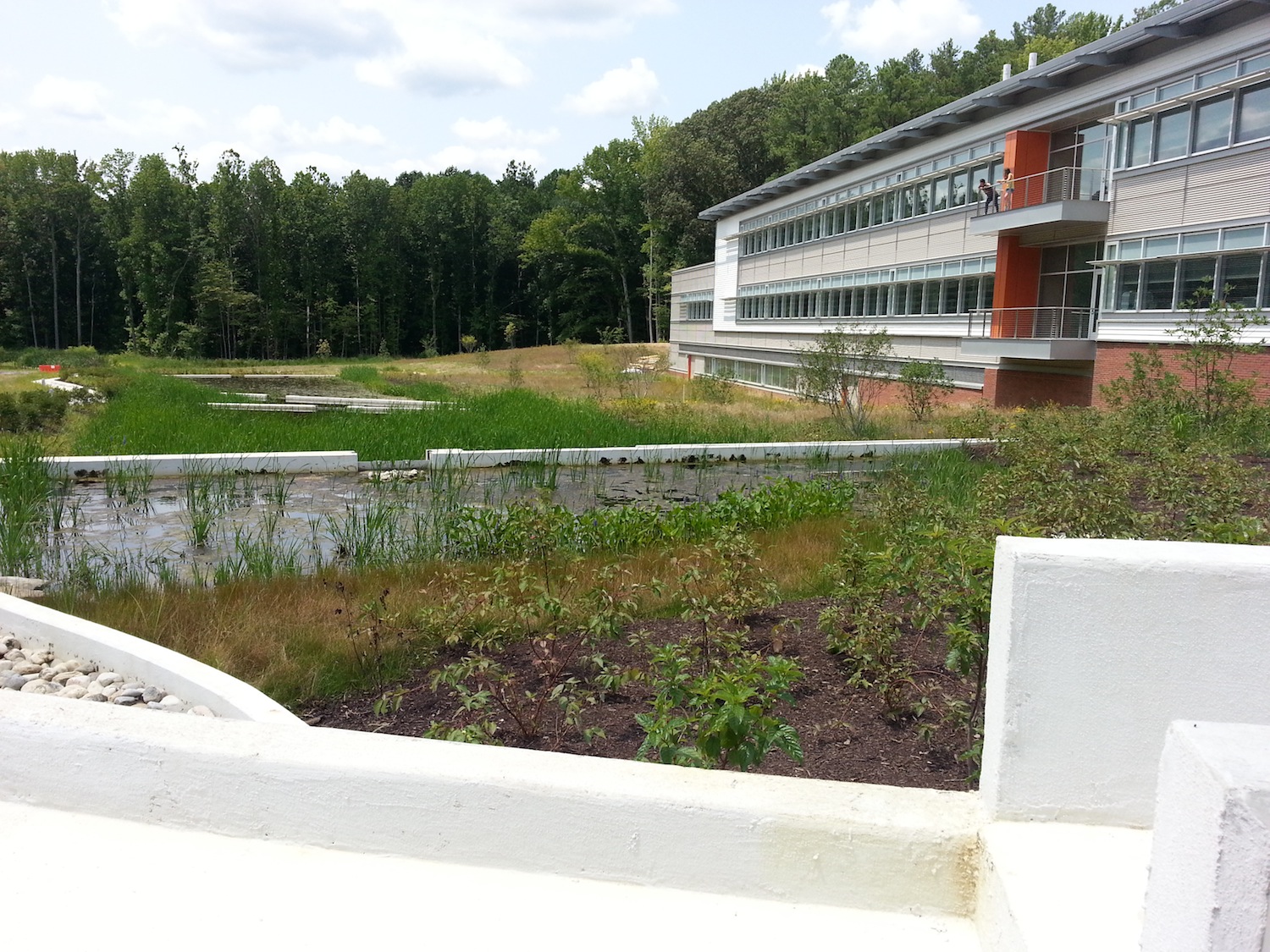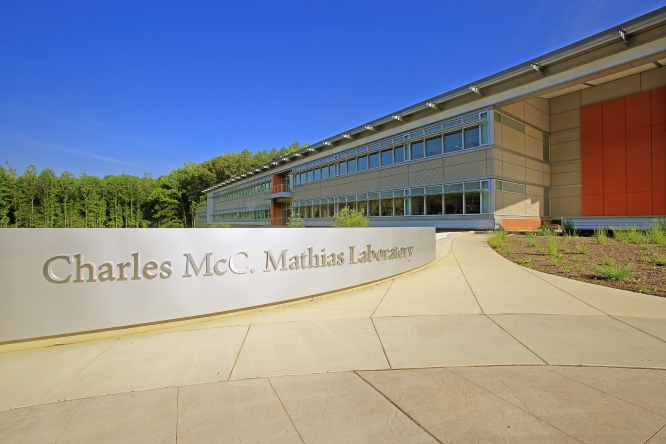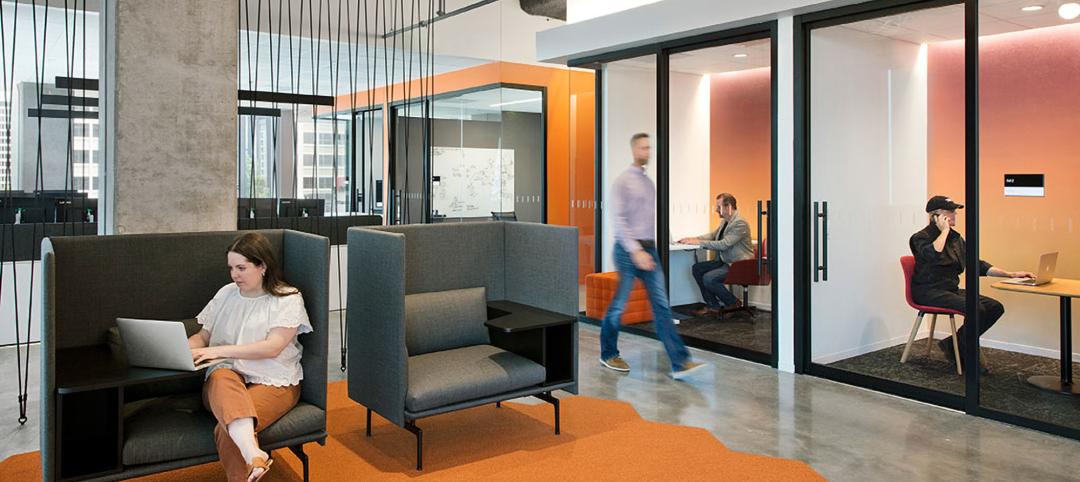The Smithsonian Institution opened the doors of its greenest building to date on Friday, Sept. 19: the Charles McC. Mathias Laboratory on the campus of the Smithsonian Environmental Research Center in Edgewater, Md. Designed to be the first Leadership in Energy and Environmental Design Platinum building in the Institution, the Mathias Lab will emit 37% less CO2 than a comparable lab that does not meet LEED-certification standards.
Before the new Mathias Lab, almost two-thirds of SERC’s office space and one-fourth of its lab space were housed in trailers. The disjointed environment hindered communication and the kind of experiments scientists were able to do.
“The new lab provides us flexible space for future cutting-edge research,” said SERC Director Anson “Tuck” Hines. “Biogenomics, conservation biology, global change—these are all at the forefront of environmental science today. The new lab gives our scientists the ability to explore new territory in a more sustainable way.”
Building a sustainable research laboratory is more difficult than building a sustainable home, office space or school, largely because research environments are highly energy intensive and typically consume three-to-four times as much electricity as other buildings. However, research efforts on climate change, invasive species and conserving the Chesapeake Bay are vital to preserving healthy ecosystems throughout the rest of the world. The challenge for lead architect Howard Skoke of EwingCole was to enhance these research projects while slashing their environmental footprint.

On the south side of the lab, this 4.65-acre constructed wetland acts as rain garden to filter stormwater. The wetland also receives irrigation as part of the lab’s system to recycle 100 percent of its water. Photo: Monaca Noble / Smithsonian Environmental Research Center
The finished lab’s reduced carbon footprint comes from a substantial reliance on renewables. A geothermal well field with 250 wells provides a highly efficient heat exchange for the lab’s HVAC system, while a 352-kilowatt array of solar panels provides water heating and covers 15 percent of the building’s annual electricity expense. Energy efficiency also received a boost from passive solar lighting, a result of its open interior design and large windows, as well as automated lighting controls and strong insulation. In total, the Mathias Lab will save an estimated 42 percent on energy costs each year compared to a lab without LEED certification.
The lab will also recycle 100% of its water through innovative interconnection of systems. All domestic “gray water” will go to a wastewater treatment plant on the SERC campus within walking distance of the lab. From there, it will be sent back to the lab for reuse in fire protection, irrigation and the water-closet supply. Some of the water will nourish the 4.5-acre constructed wetland on the lab’s south side. Three cisterns will capture rainwater to irrigate the wetland, which will filter stormwater and provide a living habitat for native plants and animals.
The majority of the project’s $57 million funding came from Congress. Construction began in May 2011 with the addition of 69,000 sf of new laboratory and office space. Renovation of the existing 23,000-sf laboratory completed the project in fall 2014.
“Mac Mathias would have loved this building as much as the research that is going to go on inside it,” said Sen. Ben Cardin (D-Md.). “This new lab will dramatically advance research efforts on conserving the Chesapeake and understanding climate change. Highly energy efficient, heavily reliant on renewable energy sources and quite beautiful, the lab is a statement on how the built and natural environments can continually complement one another.”
“As a strong supporter of the Smithsonian Environmental Research Center, I’m pleased that this new sustainable research facility will provide men and women at the forefront of environmental science with the space needed to conduct their critical work,” said Congressman Steny Hoyer (D-Md.). “Throughout my career, I’ve been proud to support investments in research and innovation, and I look forward to joining the SERC team as they open the new Mathias Lab.”
EwingCole was the design firm for the project. The general contractor was Hensel Phelps Construction Company.
Related Stories
MFPRO+ News | May 20, 2024
Florida condo market roiled by structural safety standards law
A Florida law enacted after the Surfside condo tower collapse is causing turmoil in the condominium market. The law, which requires buildings to meet certain structural safety standards, is forcing condo associations to assess hefty fees to make repairs on older properties. In some cases, the cost per unit runs into six figures.
Office Buildings | May 20, 2024
10 spaces that are no longer optional to create a great workplace
Amenities are no longer optional. The new role of the office is not only a place to get work done, but to provide a mix of work experiences for employees.
Mass Timber | May 17, 2024
Charlotte's new multifamily mid-rise will feature exposed mass timber
Construction recently kicked off for Oxbow, a multifamily community in Charlotte’s The Mill District. The $97.8 million project, consisting of 389 rental units and 14,300 sf of commercial space, sits on 4.3 acres that formerly housed four commercial buildings. The street-level retail is designed for boutiques, coffee shops, and other neighborhood services.
Construction Costs | May 16, 2024
New download: BD+C's May 2024 Market Intelligence Report
Building Design+Construction's monthly Market Intelligence Report offers a snapshot of the health of the U.S. building construction industry, including the commercial, multifamily, institutional, and industrial building sectors. This report tracks the latest metrics related to construction spending, demand for design services, contractor backlogs, and material price trends.
K-12 Schools | May 15, 2024
A new Alabama high school supports hands-on, collaborative, and diverse learning
In Gulf Shores, a city on Alabama’s Gulf Coast, a new $137 million high school broke ground in late April and is expected to open in the fall of 2026. Designed by DLR Group and Goodwyn Mills Cawood, the 287,000-sf Gulf Shores High School will offer cutting-edge facilities and hands-on learning opportunities.
Adaptive Reuse | May 15, 2024
Modular adaptive reuse of parking structure grants future flexibility
The shift away from excessive parking requirements aligns with a broader movement, encouraging development of more sustainable and affordable housing.
Affordable Housing | May 14, 2024
Brooklyn's colorful new affordable housing project includes retail, public spaces
A new affordable housing development located in the fastest growing section of Brooklyn, N.Y., where over half the population lives below the poverty line, transformed a long vacant lot into a community asset. The Van Sinderen Plaza project consists of a newly constructed pair of seven-story buildings totaling 193,665 sf, including 130 affordable units.
K-12 Schools | May 13, 2024
S.M.A.R.T. campus combines 3 schools on one site
From the start of the design process for Santa Clara Unified School District’s new preK-12 campus, discussions moved beyond brick-and-mortar to focus on envisioning the future of education in Silicon Valley.
University Buildings | May 10, 2024
UNC Chapel Hill’s new medical education building offers seminar rooms and midsize classrooms—and notably, no lecture halls
The University of North Carolina at Chapel Hill has unveiled a new medical education building, Roper Hall. Designed by The S/L/A/M Collaborative (SLAM) and Flad Architects, the UNC School of Medicine’s new building intends to train new generations of physicians through dynamic and active modes of learning.
Sustainability | May 10, 2024
Perkins&Will’s first ESG report discloses operational performance data across key metrics
Perkins&Will recently released its first ESG report that discloses the firm’s operational performance data across key metrics and assesses its strengths and opportunities.

















